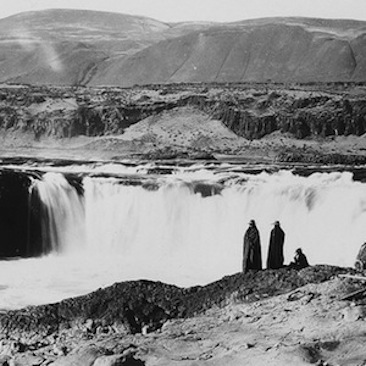From the book Pendleton Round-Up at 100: Oregon’s Legendary Rodeo.
It was a battle of the sexes that never came to pass. Not that Mabel Strickland and other cowgirls didn’t try in 1924. Emboldened by their skills and growing popularity among rodeo fans from Pendleton to New York to London, they wanted to compete directly with the cowboys.
Who could blame them? The prize money was richer and the trophies larger. Riding bucking broncos and wrestling steers to the ground, the women faced the same dangers as men. The prowess and daring of Strickland, Fox Hastings, Lorena Trickey, Prairie Rose Henderson, and others were evident. A month before the Round-Up that year, Strickland had the second best time in steer roping among cowboys and cowgirls at the Frontier Days in Cheyenne, Wyoming. Two years earlier at the Round-Up, she had roped and tied down a steer in eighteen seconds, close to the men’s world record.
Strickland and the other cowgirls asked the Round-Up board of directors to let them compete for the Roosevelt Trophy, the highest accolade a cowboy could receive. Given by the Roosevelt Hotel in New York in honor of President Theodore Roosevelt, the gold and silver trophy was awarded to the cowboy who accumulated the most points in four events at the Cheyenne and Pendleton competitions: bronc-busting, steer roping, bulldogging, and the wild horse race.
Board members knew women were big draws at the ticket gate. The attraction wasn’t just their rodeo skills, but also their flair and glamour. They posed often for photographers, usually in a group, displaying smiles, confident bearing, and colorful outfits. Strickland, who grew up near Walla Walla, Washington, also showed off her style in the rodeo ring. In what became a signature gesture at the end of an event, she’d spring up, grin broadly, and throw her hands high in the air in a bold but feminine declaration of triumph.
Cowgirls had been a major hit at the first rodeo in New York City in 1922 at Madison Square Garden, and publicity about their exploits grew. That year a socialite held a dinner for rodeo participants. A New York Herald reporter dispatched to the event wrote that Strickland, Hastings, and Bonnie McCarroll—all dressed in evening gowns—had succeeded in “utterly ruining all Eastern ideas concerning lady broncho busters.”
Cowboys disagreed about the women’s skills. Strickland’s husband Hugo, a champion at Pendleton and many other rodeos, said one roper had lobbied him to persuade Mabel to enter women-only exhibitions. “Hugh, durn it, we fellas got to stick together,” the cowboy told him. “We don’t come off good in the public’s eye with a woman beating the whey out of us steer roping” (Allen, 1992). Pink Boylen, a cowboy and Round-Up arena director for many years, praised Strickland’s roping skills but said she wasn’t as fast as the men. He also said cowboys dehorned her steers to protect her.
Women had been stars at the Round-Up since it began. Bertha Blancett came within two points of winning the competition’s all-around championship in 1911. At the time, though competing in their own events, women accumulated points toward the championship as the men did. Thirteen years later, Strickland and her cohorts wanted a shot at the Roosevelt Trophy, first awarded in 1923, and the title of “World’s Best Cowboy.” These words were inscribed on the trophy itself, formed with a silver replica of a lariat.
The Round-Up directors gave a terse answer. No. A cowboy is always a cowboy, they said.
The decision triggered widespread news coverage. In 1924, the Philadelphia Public Ledger produced a full-page feature about the cowgirls, portraying them as tough yet ladylike. Illustrated with photographs of Strickland and Hastings and appearing in newspapers around the country, it sympathetically described the failed quest of the cowgirls to gain equal footing with the men. “The girls can show up the brawny masculine champs of saddle and rope all they want, but they can’t do the boys out of the world’s cowboy championship. The men are safe, and that’s that! The board of directors of the celebrated Pendleton (Ore.) Round-Up says so.”
The board’s decision didn’t stop it from using Strickland’s stardom to best advantage. In 1927, she served as Round-Up queen and gave a steer roping demonstration.


Comments on this entry are closed.